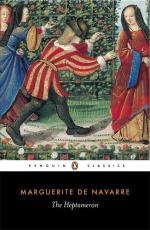Rabelais, the first book of whose Pantagruel anticipated the Paragon by three years, while the Gargantua coincided with it, was a great authority at the Court of Margaret’s brother Francis, dedicated one of the books (the third) of Pantagruel to her, before her death, in high-flown language, as esprit abstrait, ravy et ecstatic, and must certainly have been familiar reading of hers, and of all the ladies and gentlemen, literary and fashionable, of her Court. But there is little resemblance to be found in his style and hers. The short stories which Master Francis scatters about his longer work are, indeed, models of narration, but his whole tone of thought and manner of treatment are altogether alien from those of the “ravished spirit” whom he praises. His deliberate coarseness is not more different from her deliberate delicacy than his intensely practical spirit from her high-flown romanticism (which makes one think of, and may have suggested, the Court of La Quinte), and her mixture of devout and amatory quodlibetation from his cynical criticism and all-dissolving irony. But there was a contemporary of Rabelais who forms a kind of link between him and Margaret, whose work in part is very like the Heptameron, and who has been thought to have had more than a hand in it. This was Bonaventure Desperiers, a man whose history is as obscure as his works are interesting. Born in or about the year 1500, he committed suicide in 1544, either during a fit of insanity, or, as has been thought more likely, in order to escape the danger of the persecution which, in the last years of the reign of Francis, threatened the unorthodox, and which Margaret, who had more than once warded it off from them, was then powerless to avert. Desperiers,




